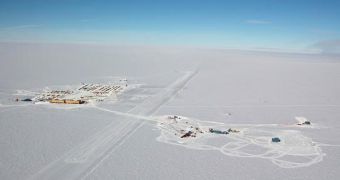This instrument will be used to detect some of nature's most mysterious subatomic particles, to create a picture of the Earth's dense iron core. It consists of a giant telescope which will be buried in the ice at the South Pole, and is designed to detect neutrinos, that present so little interaction with the normal matter, that they can easily pass through the whole mass of the planet without being severely deflected from their trajectory.
In fact, more than a hundred billion neutrinos resulted in the nuclear fusion reaction that took place in the Sun, and some coming from deep space, pass through our bodies ever second, without causing damage to our tissue. However, out of that billion, eventually a few neutrinos every day collide with the atoms causing them to release energy in form of light. The telescope will consist of thousands of detectors, which have the role of capturing the photon of light emitted by the atoms, to determine its trajectory and energy. The detector could eventually fill a volume of a cubic kilometer of ice.
However, though the previous constructed detectors have been used to study the neutrinos emitted from the Sun, meaning they where pointed upwards, this particular telescope will have its detector looking inwards to the core of the planet. This technique will help physicists filter the other radiation coming from space, through the dense core of the planet, in the hope that this would provide crucial data, with the aid of neutrinos emitted by distant supermassive black holes, such as those present in the center of the galaxies.
Though neutrinos can pass relatively easy through normal matter, passing through dense objects like the Earth's core is another thing. A large fraction of them should be stopped in their path, while others with energies exceeding 10 trillion electronvolts will be detected by IceCube to create an image of the internal structure of the planet.
Previous neutrino detectors, searching for the faint blue burst of light form a neutrino-atom collision, had little chance of detecting particles coming from deep space. IceCube is designed to find these low-energy particles, by using the diffuse glow of neutrinos created in the upper atmosphere, as a result of the interactions between energetic particles like protons, and other cosmic radiation.
The conventional method used by astronomers to calculate the Earth's iron core is to study the wobble of the planet on its orbit around the Sun. Scientists hope that by using neutrinos, they will be able to create an image similar to that created by the X-rays while studying a bone inside a living being. The neutrino picturing technique could, however, take several decades due to the fact that they have very low interaction with normal matter.

 14 DAY TRIAL //
14 DAY TRIAL //